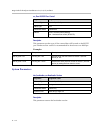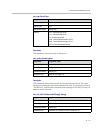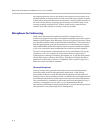
Design Guide for the Polycom SoundStructure C16, C12, C8, and SR12
B - 2
The challenge in audio conferencing is that the loudspeaker audio is not only
heard by the local participants, but it is also heard by the local microphones
and, in the absence of an acoustic echo canceller, will be sent back to the remote
participants causing the remote participants to hear a delayed echo of their
voice.
Many of the challenges in audio conferencing arise from microphone selection
and placement, loudspeaker placement, and balancing the architectural and
aesthetics of the room with the requirements for having the best audio quality.
Compromises in audio quality in favor of aesthetics will reduce the quality
and intelligibility of meetings.
In small conferencing room spaces, a tabletop conferencing phone is often an
adequate solution for audio conferencing and provides an all-in-one package
that is easy to deploy and provides good sound quality in the many room
environments.
Large Room Environments
The typical room environment introduces ambient noise (from HVAC, outside
noise, projectors, computers, etc.), in-room reflections of the audio (multipath
audio), and constraints on microphone and loudspeaker positioning.
Conference rooms should be designed to a NC 30 standard if possible. An NC
30 rating corresponds to approximately 40 dBA SPL of background noise,
leaving about 30 dB of SNR for normal talkers (70 - 77 dBA SPL at 1 meter). A
lower NC rating will further improve the quality of the audio conferencing
system by improving intelligibility and reducing listener fatigue but will also
increase the overall cost of the room build-out. For an audio system to have
good intelligibility, it is important for the signals that are heard by the local
talker to be at least 25 dB above the background noise level.
The surfaces in the room including walls, ceiling, and furniture will affect the
quality of the conferencing system. Hard surfaces will increase the amount of
reflections in the room causing multiple versions of a local talker's audio signal
to be heard by the microphones and for multiple versions of the remote talker's
signal to be heard in the local room. Multiple versions of the signals that are
time delayed with respect to each other will cause noticeable comb filtering
effects that will filter out particular frequencies (dependent on the time
separation of the multiple versions of the signals), degrading the quality of the
signal. Once the frequencies are filtered out by the comb filtering, they can not
be restored by equalization.
Often the conference room location is selected due to the outside view from the
room or because it is a convenient location. However the location of a
potential conference room should be evaluated to make sure it is not directly
underneath a building's HVAC units, nor near other environmental noise
sources such as shipping rooms, loading docks, copy rooms, network
operations centers, and other such rooms to ensure that the outside noise
sources are minimized in the conference room.


















